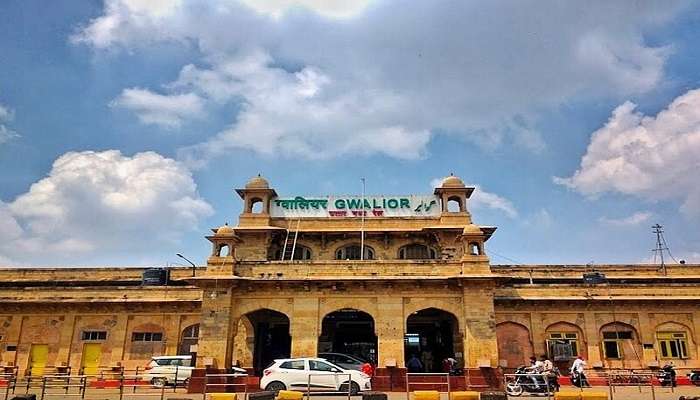Discover The Architectural Splendour Of Sas-Bahu Temple In Gwalior In 2026
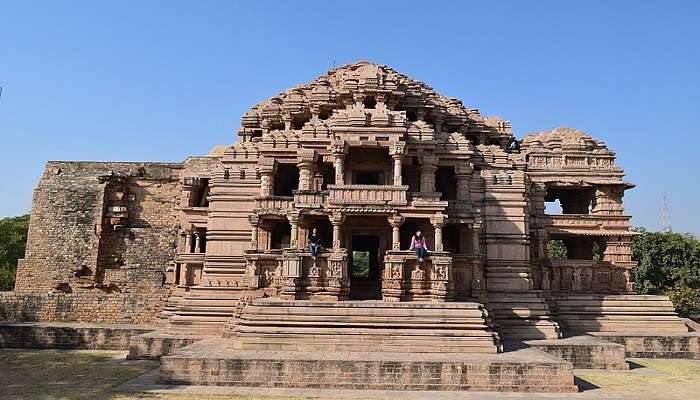
Sas-Bahu Temple Gwalior, located in the historical city of Madhya Pradesh, has stood the test of time.It is a complex of temples dedicated to the Hindu god Vishnu, and the temple is known for its beautiful carvings, detailed sculptures, and architectural grandeur. In English, the temple name means ‘Mother-in-Law’ and ‘Daughter-in-Law,’ it is two temples- big and small – which means the fusion of artistry and devotion. Sas-Bahu Temple Gwalior is one of the most popular tourist destinations in Gwalior, a city of forts known for its kings and queens in earlier times.
Historical Background Of Sas-Bahu Temple Gwalior

The Sas-Bahu Temple in Gwalior is one of the oldest temples in Gwalior and boasts several stories related to this place. It dates back to the 11th century and was built by the Kachchhapaghata dynasty during the reign of King Mahipala. Sas temple, or the greater temple, has beautiful carvings on the pillars. You can see scenes of Krishna Leela carved inside the temple.
On the other hand, Bahu temple has multiple entrances for devotees to enter the premises. You can see the sanctum inside, with images of Lord Brahma holding the Vedas in his hands and Vishnu and Shiva holding a trident. This double dedication brought about the popular name of the temple complex the Sas-Bahu Temple Gwalior.
Timings: 9 AM to 5 PM
Main Attractions: Carvings and Religious Images
Also Read: Places To Visit Near Gwalior
Architecture Of Sas-Bahu Temple Gwalior

The Sas-Bahu Temple Gwalior complex is a beautiful epitome of ancient Indian temple architecture. The enormous temple, full of grandeur, is ornamented with exquisite carvings of various religious and mythological scenes, celestial beings, and intricate floral patterns. While the smaller temple may not be as grand as its counterpart, it is undoubtedly no less rich in its expression of the artistic mind; it represents the dedication and skill of the craftsmen who created these works very well.
The bigger Sas-Bahu Temple Gwalior is a three-storeyed building comprising a sanctum. On the temple’s outer walls are thorough carvings of deities, celestial beings and scenes from Hindu mythology. You will be amazed to see the finesse and skill of the artisans who did this intricate and precise work in this temple. The smaller temple is also a simple version of the latter but reflects the same artistic genius as its larger counterpart. This, too, has a rectangular shape with an idol of Lord Shiva enshrined. The walls and the pillars are profusely carved with themes from Hindu mythology, reflecting the skill and workmanship of the times.
Photography: Photography is allowed, but the use of flash is prohibited
Guided Tours: Our guided tour will help you to understand the historical significance of the temple
Carvings And Spiritual Significance

One of the most striking features of this temple is its minute carvings. A large number of sculptures and frescoes adorn the outer walls of both temples, narrating stories from Hindu mythology. The carvings include depictions of various deities and other mythical elements. The detail and precision in the work done here are truly amazing and a treat for visitors to this place.
The Sas-Bahu Temple Gwalior is an architectural marvel and holds spiritual value. The complex attracts devotees from across the country who come to bathe in the blessings and worship the deities. The temple’s serene ambience, rich history, and architectural heritage make it very quiet and spiritually attractive for tourists.
Related Post: Things To Do In Gwalior
Nearby Local Attractions
Several tourist attractions near Sas-Bahu Temple Gwalior are worth exploring. Some of the most popular places to visit near Sas-Bahu Temple are mentioned below:
1. Gwalior Fort
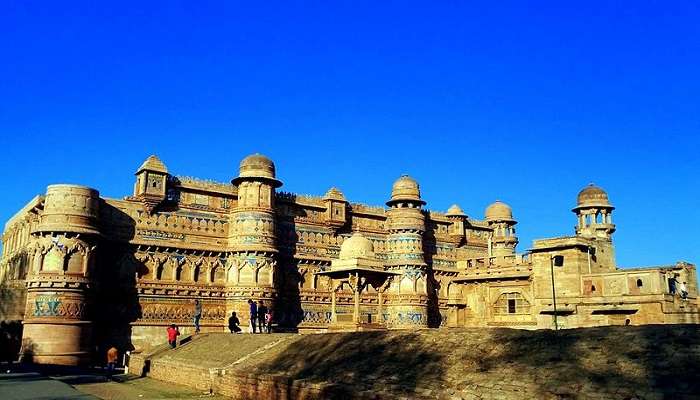
The Gwalior Fort stands on top of a hill in Gwalior, a city in the state of Madhya Pradesh, and depicts immense architectural beauty with great strategic importance. This enormous fort complex, spanning many centuries, contains palaces, temples, and museums that relate individual stories about the majestic past of India. Some of the main buildings are the Man Singh Palace, featuring magnificent latticework, and the temples of Saas Bahu, which display beautiful carvings. This fort presents a panoramic view of the city. It is a blend of Rajput and Mughal architecture styles, making it an important place to visit for a history enthusiast and a traveller alike.
Location: About 4 km from the Temple
Timing: From 9 AM to 5 PM
2. Teli Ka Mandir
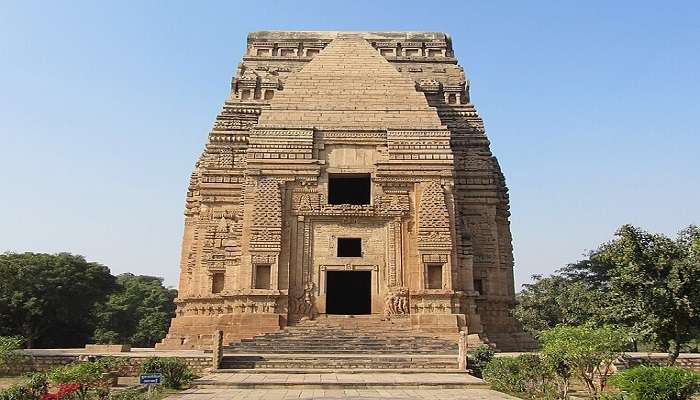
Teli Ka Mandir, built inside the Gwalior Fort complex in Madhya Pradesh, is the most outstanding example of architectural genius. This towering temple stands distinct with its unique blending of Dravidian and North Indian styles of architecture. It is dedicated to Vishnu and comprises a rectangular sanctum with an imposing Shikhara. The outer walls are profusely ornamented with intricate carvings of various deities and mythological scenes. Teli Ka Mandir is singular both in design and historical importance, making it one of the imperative visitor attractions of the Gwalior Fort. This provides a view of the place’s rich cultural and architectural heritage.
Location: About 1 km from the Temple
Timing: From 9 AM to 5 PM
Related Post: Omkareshwara Temple
3. Jai Vilas Palace
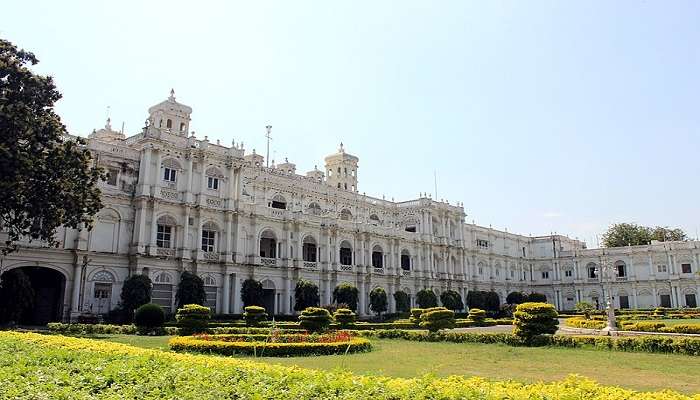
The Jai Vilas Palace in Gwalior, Madhya Pradesh, is one of the finest examples of architecture. Constructed under the reign of Maharaja Jayajirao Scindia, it combines Italianate, Corinthian, and Tuscan styles of architecture. Having 1,240 rooms, this magnificent building hosts the Scindia Museum, whose treasures include ornate furniture, royal costumes, and historic manuscripts. The lavish Durbar Hall, with massive chandeliers and gold-plated ceilings, displays the royal luxury of this place. This visit to the Jai Vilas Palace gives an exciting insight into the Scindia dynasty’s luxurious lifestyle and wealthy history.
Location: About 5 km from the Temple
Timing: From 9 AM to 5 PM
4. Gujari Mahal
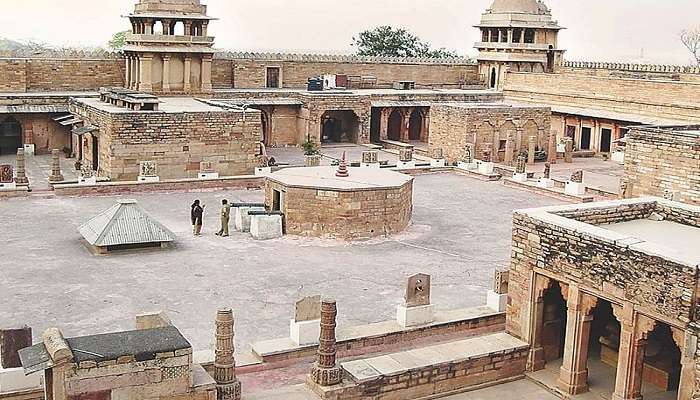
Within the complex of Gwalior Fort lies Gujari Mahal, a palace built in the 15th century that is now turned into an archaeological museum. It houses many exhibits but mainly features sculptures, pieces of pottery, and ancient inscriptions—these facilitate tools to understand the region’s past.
Location: About 4 km from the Temple
Timing: From 9 AM to 5 PM
Related Post: Shree Bijasan Mata Mandir
How To Reach The Temple 
By Air: The nearest airport is the Rajmata Vijaya Raje Scindia Air Terminal in Gwalior. It has good connectivity to all the major cities in India. You can hire a taxi or get on a bus from the airport itself to reach the temple complex.
By Train: Gwalior Junction is the nearest railway station. Connectivity to this part of the country is excellent. You can hire a taxi or an auto rickshaw from the railway station to visit the Sas-Bahu Temple Gwalior.
By Road: Gwalior is well-connected by road, and regular bus services run from the major cities of Madhya Pradesh and nearby states. You can also drive down to Gwalior or take a hired taxi for a comfortable journey.
You May Also Like Read: Places To Visit In Gwalior
The Sas-Bahu Temple Gwalior of Gwalior is an ancient preservation of Indian architecture and art. The intricate carvings, historical importance, and spiritual surroundings make it a must-visit for people looking to learn more about India’s vast and rich culture. Be it history buffs, architecture enthusiasts, or those seeking spirituality, the temple is sure to give an enriching and unforgettable experience to every visitor. Plan your visit to Gwalior and book your trip to Madhya Pradesh to soak in the timeless beauty and grandeur of the Sas-Bahu Temple Gwalior.
For our editorial codes of conduct and copyright disclaimer, please click here.
Cover Image Credit: Kshitiz Sikka for Wikimedia Commons
Frequently Asked Questions About Sas-Bahu Temple Gwalior
What is the Sas-Bahu Temple Gwalior famous for?
The Sas-Bahu Temple Gwalior is known for its magnificent carvings and vivid sculptures, along with other outstanding architecture, that evidences the immaculate artistry and craftwork of ancient India.
Are the Sas-Bahu Temple Gwalior open to all?
Yes, the Sas-Bahu Temple Gwalior is open to all. The entry to the temple is not discriminated on any caste, religion, gender etc. However, one should dress modestly since it is a sacred place.
Is Photography allowed in Sas-Bahu Temple Gwalior?
Yes, it is allowed to take photographs at this temple. However, flash clicking should be avoided as it might affect the finely carved sculptures.
What are the best timings to visit the Sas-Bahu Temple Gwalior?
The best time to visit the Sas-Bahu Temple Gwalior would be from October to March during winter months when the climate is pleasant and suitable for visiting the temple complex.
How to reach Sas-Bahu Temple Gwalior?
Sas-Bahu Temple Gwalior is located in Gwalior, Madhya Pradesh. You can reach Gwalior either by air, rail, or road and then take a taxi or bus to the temple complex.
People Also Read:
ISKCON Temple Guntur Omkareshwara Temple Anubhavi Subramaniar Temple

With a passion for exploring and travelling to the roads long forgotten, experience the world through enthralling stories and adventures. Join me as I share my experiences at some of the world’s most popular tourist destinations and quench that pestering curiosity with something exciting!
